Immunocytochemical localization of TASK-3 (K(2P)9.1) channels in monoaminergic and cholinergic neurons
- PMID: 21082237
- PMCID: PMC11498383
- DOI: 10.1007/s10571-010-9625-6
Immunocytochemical localization of TASK-3 (K(2P)9.1) channels in monoaminergic and cholinergic neurons
Abstract
Monoaminergic and cholinergic systems are important regulators of cortical and subcortical systems, and a variety of vegetative functions are controlled by the respective neurotransmitters. Neuronal excitability and transmitter release of these neurons are strongly regulated by their potassium conductances carried by Kir and K(2P) channels. Here we describe the generation and characterization of a polyclonal monospecific antibody against rat TASK-3, a major brain K(2P) channel. After removal of cross-reactivities and affinity purification the antibody was characterized by ELISA, immunocytochemistry of TASK-3 transfected cells, and Western blots indicating that the antibody only detects TASK-3 protein, but not its paralogs TASK-1 and TASK-5. Western blot analysis of brain membrane fractions showed a single band around 45 kD, close to the predicted molecular weight of the TASK-3 protein. In addition, specific immunolabeling using the anti-TASK-3 antibody in Western blot analysis and immunocytochemistry was blocked in a concentration dependent manner by its cognate antigen only. Immunocytochemical analysis of rat brain revealed strong expression of TASK-3 channels in serotoninergic neurons of the dorsal and median raphe, noradrenergic neurons of the locus coeruleus, histaminergic neurons of the tuberomammillary nucleus and in the cholinergic neurons of the basal nucleus of Meynert. Immunofluorescence double-labeling experiments with appropriate marker enzymes confirmed the expression of TASK-3 in cholinergic, serotoninergic, and noradrenergic neurons. In the dopaminergic system strong TASK-3 expression was found in the ventral tegmental area, whereas TASK-3 immunoreactivity in the substantia nigra compacta was only weak. All immunocytochemical results were supported by in situ hybridization using TASK-3 specific riboprobes.
Figures
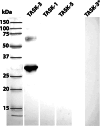

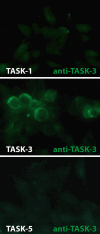
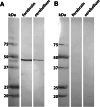

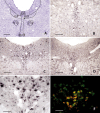



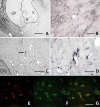
Similar articles
-
Immunocytochemical localization of TASK-3 channels in rat motor neurons.Cell Mol Neurobiol. 2012 Mar;32(2):309-18. doi: 10.1007/s10571-011-9762-6. Epub 2011 Oct 20. Cell Mol Neurobiol. 2012. PMID: 22011781 Free PMC article.
-
Detection of corticotropin-releasing hormone receptor 1 immunoreactivity in cholinergic, dopaminergic and noradrenergic neurons of the murine basal forebrain and brainstem nuclei--potential implication for arousal and attention.Neuroscience. 2001;104(3):643-52. doi: 10.1016/s0306-4522(01)00137-3. Neuroscience. 2001. PMID: 11440798
-
Co-expression of non-selective cation channels of the transient receptor potential canonical family in central aminergic neurones.J Neurochem. 2003 Jun;85(6):1547-52. doi: 10.1046/j.1471-4159.2003.01806.x. J Neurochem. 2003. PMID: 12787073
-
Ascending monoaminergic systems alterations in Alzheimer's disease. translating basic science into clinical care.Neurosci Biobehav Rev. 2013 Sep;37(8):1363-79. doi: 10.1016/j.neubiorev.2013.05.008. Epub 2013 May 24. Neurosci Biobehav Rev. 2013. PMID: 23707776 Review.
-
Regulation of release processes in central serotoninergic neurons.J Physiol (Paris). 1981;77(2-3):287-301. J Physiol (Paris). 1981. PMID: 6457140 Review.
Cited by
-
Patterned expression of ion channel genes in mouse dorsal raphe nucleus determined with the Allen Mouse Brain Atlas.Brain Res. 2012 May 31;1457:1-12. doi: 10.1016/j.brainres.2012.03.066. Epub 2012 Apr 4. Brain Res. 2012. PMID: 22534482 Free PMC article.
-
TASK Channels on Basal Forebrain Cholinergic Neurons Modulate Electrocortical Signatures of Arousal by Histamine.J Neurosci. 2015 Oct 7;35(40):13555-67. doi: 10.1523/JNEUROSCI.1445-15.2015. J Neurosci. 2015. PMID: 26446210 Free PMC article.
-
Immunocytochemical localization of TASK-3 protein (K2P9.1) in the rat brain.Cell Mol Neurobiol. 2014 Jan;34(1):61-70. doi: 10.1007/s10571-013-9987-7. Cell Mol Neurobiol. 2014. PMID: 24077856 Free PMC article.
-
Selective Knockdown of TASK3 Potassium Channel in Monoamine Neurons: a New Therapeutic Approach for Depression.Mol Neurobiol. 2019 Apr;56(4):3038-3052. doi: 10.1007/s12035-018-1288-1. Epub 2018 Aug 7. Mol Neurobiol. 2019. PMID: 30088175
-
Immunocytochemical localization of TASK-3 channels in rat motor neurons.Cell Mol Neurobiol. 2012 Mar;32(2):309-18. doi: 10.1007/s10571-011-9762-6. Epub 2011 Oct 20. Cell Mol Neurobiol. 2012. PMID: 22011781 Free PMC article.
References
-
- Bayliss DA, Talley EM, Sirois JE, Lei Q (2001) TASK-1 is a highly modulated pH-sensitive ‘leak’ K(+) channel expressed in brainstem respiratory neurons. Respr Physiol 129:159–174 - PubMed
-
- Bird MK, Reid CA, Chen F, Tan HO, Petrou S, Lawrence AJ (2009) Cocaine-mediated synaptic potentiation is absent in VTA neurons from mGlu5-deficient mice. Int J Neuropsychopharmacol 13:133–141 - PubMed
MeSH terms
Substances
LinkOut - more resources
Full Text Sources

